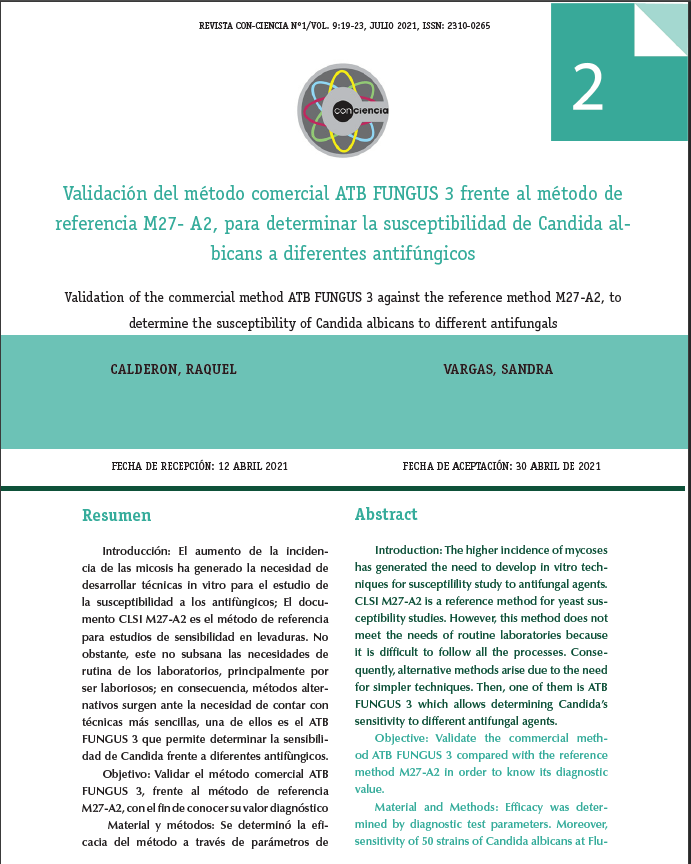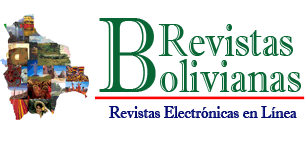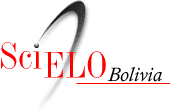EVALUACIÓN DEL MÉTODO COMERCIAL ATB FUNGUS 3 FRENTE AL MÉTODO DE REFERENCIA M 27 – A2, PARA DETERMINAR LA SUSCEPTIBILIDAD DE CANDIDA ALBICANS A DIFERENTES ANTIFUNGICOS
Validation of the commercial method ATB FUNGUS 3 against the reference method M27-A2, to determine the susceptibility of Candida albicans to different antifungals
DOI:
https://doi.org/10.53287/ryhm2292ui11qPalabras clave:
CIM, Método de referencia, EVALUACIÒN - VALIDACIÒNResumen
Introducción: El aumento de la incidencia de las micosis ha generado la necesidad de desarrollar técnicas para el estudio de la susceptibilidad in vitro a los antifúngicos; El documento M27-A2 es el método de referencia para estudios de sensibilidad en levaduras. No obstante, estos no subsanan las necesidades de rutina de los laboratorios, principalmente por ser laboriosos; en consecuencia, métodos alternativos surgen ante la necesidad de contar con técnicas menos laboriosas, el ATB FUNGUS 3, permite determinar la sensibilidad de Candida frente a diferentes antifungicos.
Objetivo: Evaluar el método comercial ATB FUNGUS 3, frente al método de referencia M27-A2, con el fin de conocer su valor diagnóstico
Material y métodos: Se determinó la eficacia del método comercial a través de parámetros de test diagnóstico. S estudiaron 50 cepas de Cándida albicans, en las que se determinó la sensibilidad a Fluconazol (FLZ) e itraconazol (ITZ) por ambos métodos.
Resultados: Se encontró que el ATB - FUNGUS 3 presenta una especificidad para FLZ de 100 %, sensibilidad de 91%, valor predictivo positivo (VPP) de 56%, valor predictivo negativo (VPN) de 100%, con una eficacia diagnóstica de 92%, calculados para un intervalo de confianza (IC) de 95%; para ITZ la especificidad y sensibilidad fue de 88 % y 90% respectivamente, con un VPP de 64%, un VPN de 97% y eficacia diagnóstica de 90%, IC 95%. Para las pruebas de concordancia, el índice Kappa para FLZ e ITZ fue de 0.67 y 0,68 respectivamente. La prueba de Likelihood ratio para el FLZ fueron (LR+) de 11,25 y el (LR-) fue de 0; para el ITZ (LR+) de 9,19 y el (LR-) fue de 0,14. Reproducibilidad de 90 % (FLZ) y 85% (ITZ).
Conclusiones: El ATB FUNGUS 3, es una técnica reproducible, rápida y de fácil realización; pero el desempeño global de la técnica, sugiere que aún no es confiable para su uso en los laboratorios, debido a los valores bajos obtenidos en los VPP, lo que podría derivar en errores al momento de determinar una cepa como sensible o resistente, punto importante al momento de decidir la conducta terapéutica.
Palabras clave: CIM, Método de referencia
ABSTRACT:
Introduction: The increase in the incidence of mycoses has generated the need to develop techniques for the study of in vitro susceptibility to antifungals; Document M27-A2 is the reference method for yeast sensitivity studies. However, these do not meet the routine needs of laboratories, mainly because they are laborious; Consequently, alternative methods arise due to the need for less laborious techniques, the ATB FUNGUS 3, allows determining the sensitivity of Candida against different antifungals.
Objective: To evaluate the commercial method ATB FUNGUS 3, against the reference method M27-A2, in order to know its diagnostic value
Material and methods: The efficacy of the commercial method was determined through diagnostic test parameters. Studied 50 strains of Candida albicans, in which the sensitivity to Fluconazole (FLZ) and itraconazole (ITZ) was determined by both methods.
Results: It was found that ATB - FUNGUS 3 presents a specificity for FLZ of 100%, sensitivity of 91%, positive predictive value (PPV) of 56%, negative predictive value (NPV) of 100%, with a diagnostic efficacy of 92 %, calculated for a 95% confidence interval (CI); for ITZ, the specificity and sensitivity were 88% and 90% respectively, with a PPV of 64%, a NPV of 97% and diagnostic efficacy of 90%, 95% CI. For the concordance tests, the Kappa index for FLZ and ITZ was 0.67 and 0.68 respectively. The Likelihood ratio test for the FLZ were (LR +) 11.25 and the (LR-) was 0; for the ITZ (LR +) of 9.19 and the (LR-) was of 0.14. Reproducibility of 90% (FLZ) and 85% (ITZ).
Conclusions: The ATB FUNGUS 3 is a reproducible, fast and easy to perform technique; but the overall performance of the technique suggests that it is not yet reliable for use in laboratories, due to the low values obtained in PPV, which could lead to errors when determining a strain as sensitive or resistant, an important point when deciding on therapeutic behavior.
Keywords: CIM, Reference method






 Revista Con-Ciencia
Revista Con-Ciencia revista.conciencia.biofar
revista.conciencia.biofar Revista Con-Ciencia
Revista Con-Ciencia






